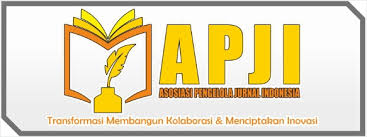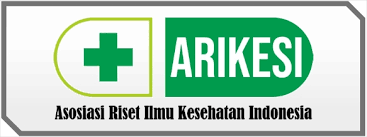Isolation and Characterization of Lactic Acid Bacteria From Sago Wastewater As Antibacterial
Abstract
Background: Foodborne diseases are infections of the gastrointestinal tract caused by food containing microbiological agents and usually, these infections affect groups of individuals who have low immune systems. Lactic acid bacteria (LAB)are bacillus-shaped Gram-positive bacteria that work by inhibiting pathogenic bacteria that cause foodborne diseases. Maluku is a region in Indonesia rich in sago production. Sago ihur (Metroxylon sylvestre) and tuni (Metroxylon rumphii) are types of sago commonly found in Maluku. Sago is rich in carbohydrates and therefore has the opportunity to produce LAB. This study aimed to isolate and characterize LAB from sago wastewater was a laboratory experimental research with descriptive method using primary data. Methods: Bacterial isolation was carried out using a selective media. Characterization carried out by macroscopicly characterization by observing shape, margin, elevation, pigmentation, appearance, optical properties, and texture. Microscopic characterization was performed using Gram and spore staining. Results: The results of this study showed that five bacterial isolates (I1, I2, T3, T4, and I5) were successfully isolated in a round shape, flat edges, yellowish white color (not pigmented), shiny appearance, and mucoid texture, but isolate T3 showed a raised elevation and translucent to light (transparent), while for other isolates it was convex and translucent, and non-spore forming gram positive. Conclusion: Antibacterial tests against S. aureus and E. coli showed no inhibition zones. LAB isolates from sago wastewater showed no significant antibacterial effect
Keywords
Full Text:
PDFReferences
Abbasiliasi, S., Tan, J. S., Tengku Ibrahim, T. A., Bashokouh, F., Ramakrishnan, N. R., Mustafa, S., & Ariff, A. B. (2017). Fermentation Factors Influencing the Production of Bacteriocins By Lactic Acid Bacteria: a Review. RSC Advances, 7(47), 29395–29420. https://doi.org/10.1039/c6ra24579j
Adjie, A. P., & Setyawatiningsih, S. C. (2021). Potential of Lactic Acid Bacteria from Tape and Jember Tempeh as A Probiotic Candidate. Jurnal Biodjati, 6(2), 246–254. https://doi.org/10.15575/biodjati.v6i2.9462
Agustine, L., Okfrianti, Y., & Jumiyati, J. (2018). Identifikasi Total Bakteri Asam Laktat (BAL) pada Yoghurt dengan Variasi Sukrosa dan Susu Skim. Jurnal Dunia Gizi, 1(2), 79–83. https://doi.org/10.33085/jdg.v1i2.2972
Alang, H., Kusnadi, J., Ardiyati, T., & Suharjono. (2019). Identification of Lactic Acid Bacteria as Antimicrobial From Milk Toraja Belang
Buffalo. IOP Conference Series: Earth and Environmental Science, 11(1), 539–547. https://doi.org/10.1088/1755-1315/230/1/012092
Aritonang, S. N., Roza, E., Rossi, E., Purwati, E., & Husmaini. (2017). Isolation and Identification of Lactic Acid Bacteria from Okara and Evaluation of Their Potential as Candidate Probiotics. Pakistan Journal of Nutrition, 16(8), 618–628. https://doi.org/10.3923/pjn.2017.618.628
Ayivi, R. D., Gyawali, R., Krastanov, A., Aljaloud, S. O., Worku, M., Tahergorabi, R., … Ibrahim, S. A. (2020). Lactic Acid Bacteria: Food Safety and Human Health Applications. Dairy, 1(3), 202–232. https://doi.org/10.3390/dairy1030015
Azizah, S. N., Eryani, M. C., & Azizah, A. (2021). Potential Of Lactic Acid Bacteria from Tape and Jember Tempeh as a Probiotic Candidate. Jurnal Biodjati, 6(2), 273–283. https://doi.org/10.15575/biodjati.v6i2.9462
Bounaix, M. S., Gabriel, V., Morel, S., Robert, H., Rabier, P., Remaud-Siméon, M., … Fontagné-Faucher, C. (2009). Biodiversity of Exopolysaccharides Produced from Sucrose by Sourdough Lactic Acid Bacteria. Journal of Agricultural and Food Chemistry, 57(22), 10889–10897. https://doi.org/10.1021/jf902068t
Chittora, D., Meena, B. R., Jain, T., & Sharma, K. (2022). Biopreservation: Bacteriocins and Lactic Acid Bacteria. Journal of Postharvest Technology, 10(2), 1–15.
Choi, S. Y., & Beuchat, L. R. (1994). Growth Inhibition of Listeria monocytogenes by a Bacteriocin of Pediococcus acidilactici M During Fermentation of Kimchi. Food Microbiology, 11, 301–307.
Cruchet, S., Furnes, R., Maruy, A., Hebel, E., Palacios, J., Roberto, Y., … Xo, L. (2015). The Use of Probiotics in Pediatric Gastroenterology: A Review of the Literature and Recommendations by Latin-American Experts. Pediatr Drugs, 17, 199–216. https://doi.org/10.1007/s40272-015-0124-6
Damayanti, S. S., Komala, O., & Effendi, E. M. (2018). Identifikasi Bakteri dari Pupuk Organik Cair Isi Rumen Sapi. Ekologia, 18(2), 63–71. https://doi.org/10.33751/ekol.v18i2.1627
Delvia, F., Fridayanti, A., & Ibrahim, A. (2015). Isolasi dan Identifikasi (BAL) dari Buah Mangga (Mangifera indica L.). Jurnal Ilmiah Manuntung, 1(2), 159–163. https://doi.org/10.25026/mpc.v1i1.16
Detha, A., Datta, F. U., Beribe, E., Foeh, N., & Nemay, N. (2019). Karakteristik Bakteri Asam Laktat yang Diisolasi dari Susu Kuda Sumba. Jurnal Kajian Veteriner, 7(1), 85–92. https://doi.org/10.35508/jkv.v7i1.1058
Edy, F., Harmileni, H., & Anggraini, S. (2022). Pengantar Teknik Laboratorium Mikrobiologi dan Pengenalan Bakteri Asam Laktat. Medan: UNPRI Press.
Fadila, D. S. R., Hasanati, J., Kusumawardhani, A. S., Rachman, M. F., Pikoli, M., & Sugoro, I. (2022). Bakteriosin dari Bakteri Asam Laktat sebagai Biopreservasi pada Daging dan Olahannya: Tinjauan dari Potensi Hingga Industrinya. Journal Pro-Life, 9(1), 300–315.
Grace, D. (2023). Burden of Foodborne Disease in Low-Income and Middle-Income Countries and Opportunities for Scaling Food Safety Interventions. Food Security, 15(6), 1475–1488. https://doi.org/10.1007/s12571-023-01391-3
Harissa, S. F., & Hasanah, U. (2019). Identifikasi dan Karakterisasi Bakteri Asam Laktat Pada Acar Ketimun (Cucumis sativus L.) Sebagai Agensi Probiotik. Jurnal Teknologi Pangan Dan Kesehatan, 1(1), 31–37. https://doi.org/10.36441/jtepakes.v1i1.182
Ibrahim, S. A., Ayivi, R. D., Zimmerman, T., Siddiqui, S. A., Altemimi, A. B., Fidan, H., … Bakhshayesh, R. V. (2021). Lactic Acid Bacteria as Antimicrobial Agents: Food Safety And Microbial Food Spoilage Prevention. Foods, 10(12), 1–13.
https://doi.org/10.3390/foods10123131
Jufri, R. F. (2020). Microbial Isolation. Journal La Lifesci, 01(01), 18–23.
Kasi, P. D., Ariandi, & Mutmainnah, H. (2017). Isolation and Characterization of Indigenous Lactic Acid Bacteria from Sago Wastewater. Proceedings of the 4th International Seminar on Sciences, 1–4.
Kasi, P. D., & Mutmainnah, H. (n.d.). Isolasi dan Karakterisasi Bakteri Asam Laktat Asli Sagu air limbah, 1–4.
Kurnia, M., Amir, H., & Handayani, D. (2020). Isolasi dan Identifikasi Bakteri Asam Laktat dari Makanan Tradisional Suku Rejang di Provinsi Bengkulu: “Lemea.†Alotrop, 4(1), 25–32.
https://doi.org/10.33369/atp.v4i1.13705
Laily, I. N., Utami, R., & Widowati, E. (2013). Isolasi dan Karakterisasi Bakteri Asam Laktat Penghasil Riboflavin dari Produk Fermentasi Sawi Asin. Jurnal Aplikasi Teknologi Pangan, 2(4), 179–184.
Lund, B. M., & O’Brien, S. J. (2011). The Occurrence and Prevention of Foodborne Disease in Vulnerable People. Foodborne Pathogens and Disease, 8(9), 961–973. https://doi.org/10.1089/fpd.2011.0860
Man, J. M., Rogosa, C. DE, & Sharpe, M. E. (1960). A Medium for The Cultivation of Lactobacilli. Journal of Bacteriology, 23(1), 130–135. https://doi.org/10.1128/jb.51.4.560-561.1946
Mechai, A., Debabza, M., & Zouari, S. (2020). Antagonistic Activity of Lactic Acid Bacteria Isolated from Algerian Traditional Fermented Milks Against Multi-Drug Resistant and Β-Lactamase-Producing Pathogenic Bacteria. Research Journal of Biotechnology, 15(4), 1–8.
Moore, G. S., & Bell, K. A. (2018). Foodborne Illness. NIDDIK, 17(1),
–12. https://doi.org/10.1201/9780429031809-8
Musaid, S. A., Hariyanti, D., Asrida, W., Hariyati, T. R., Akuntansi, J., & Negeri, P. (2019). Produk Sagu Tumbu pada Kelompok Usaha Sagu Tumbu di Desa Liang Kecamatan Salahutu Kabupaten Maluku Tengah. Jurnal Pengabdian Masyarakat Jamak (Manajemen & Akuntansi), 02(01), 67–80.
Nelsen, M. P., Lücking, R., Boyce, C. K., Lumbsch, H. T., Ree, R. H., Hodkinson, B. P., … Balderas, Y. C. (2021). Campbell Biology. Angewandte Chemie International Edition (9th ed).
Ningsih, N. P., Sari, R., & Pratiwi, A. (2018). Optimasi Aktivitas Bakteriosin yang Dihasilkan oleh Lactobacillus Brevis dari Es Pisang Ijo. Jurnal Pendidikan Informatika dan Sains, 7(2), 233–242. https://doi.org/10.31571/saintek.v7i2.1063
Noman, A. E., Al-Barha, N. S., Sharaf, A. A. M., Al-Maqtari, Q. A., Mohedein, A., Mohammed, H. H. H., & Chen, F. (2020). A Novel Strain of Acetic Acid Bacteria Gluconobacter Oxydans FBFS97 Involved in Riboflavin Production. Scientific Reports, 10(1), 1–17. https://doi.org/10.1038/s41598-020-70404-4
Prestinaci, F., Pezzotti, P., & Pantosti, A. (2016). Antimicrobial Resistance: a Global Multifaceted Phenomenon. Pathogens and Global Health, 109(7), 309–318. https://doi.org/10.1179/2047773215Y.0000000030
Qiao, Y., Qiu, Z., Tian, F., Yu, L., Zhao, J., Zhang, H., … Chen, W. (2022). Effect of Bacteriocin-Producing Pediococcus Acidilactici Strains on The Immune System and Intestinal Flora of Normal Mice. Food Science and Human Wellness, 11(2), 238–246. https://doi.org/10.1016/j.fshw.2021.11.008
Qonita, S. B., Johan, V. S., & Rahmayuni. (2018). Identifikasi Genus Bakteri Asam Laktat dari Nira Aren Terfermentasi Spontan. JOM FAPERTA, 5(1), 1–12.
Roseveld, J. S. B., Astuty, E., & Taihuttu, Y. (2022). Uji Antibakteri Ekstrak Etanol Daging Buah Pala (Myristica fragrans Houtt.) terhadap Bakteri Staphylococcus aureus dan Escherichia coli. Pameri, 4(1), 36–
Shembil, S. S. (2016). Isolation of Lactic Acid Bacteria with Antimicrobial Activity. BRAC University.
Siahaya, T. E., Sahureka, M., & Seite, D. (2021). Analisis Produksi Sagu (Studi Kasus di Desa Hatunuru Kecamatan Taniwel Timur Kabupaten Seram Bagian Barat. Makila: Jurnal Penelitian Kehutanan,
(1), 58–69.
Sizar, O., & Unakal, C. G. (2021). Gram Positive Bacteria. Florida: Statpearls.
Suzuki, T., & Yamasato, K. (1994). Phylogeny of Spore-Forming Lactic Acid Bacteria Based on 16S rRNA Gene Sequences. FEMS Microbiology Letters, 115(1), 13–17. https://doi.org/10.1111/j.1574-6968.1994.tb06607.x
Tirta, P., Indrianti, N., & Ekafitri, R. (2013). Potensi Tanaman Sagu (Metroxylon sp.) dalam Mendukung Ketahanan Pangan di Indonesia. Pangan, 22(1), 61–76. https://doi.org/https://doi.org/10.33964/jp.v22i1.78
Vanniyasingam, J., Kapilan, R., & Vasantharuba, S. (2019). Isolation and Characterization of Potential Probiotic Lactic Acid Bacteria Isolated from Cow Milk and Milk Products. AGRIEAST: Journal of Agricultural Sciences, 13(1), 32–43. https://doi.org/http://dx.doi.org/10.4038/agrieast.v13i1.62
Vella, F. (2022). Introduction to Microbiology. Virginia: ATCC. https://doi.org/10.1002/bmb.2002.494030029997
Vinderola, G., Ouwehand, A. C., Salminen, S., & Wright, A. Von. (2019). Lactic Acid Bacteria- Microbiological and Functional Aspects (5 edition). United Kingdom: Taylor & Francis Group, LLC.
WHO. (2015). Food-Borne Disease Burden Epidemiology Reference Group. World Health Organization. https://doi.org/10.1007/978-3-642-27769-6_3884-1
DOI: http://dx.doi.org/10.30742/jikw.v13i1.3022
Refbacks
- There are currently no refbacks.
Copyright (c) 2024 Satwika Tri Rahmadana, Eka Astuty, Ony Wibriyono Angkejaya

This work is licensed under a Creative Commons Attribution-NonCommercial 4.0 International License.
Jurnal Ilmiah Kedokteran Wijaya Kusuma is licensed under a Creative Commons Attribution-NonCommercial 4.0 International License










